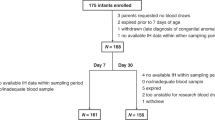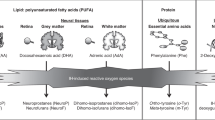Abstract
Previous studies have shown that plasma lipoproteins are a common target of free radical-induced oxidative stress in hypoxic newborn infants. In contrast to lipids, the reaction of proteins with various oxidants during hypoxia has not been extensively studied. We tested the hypothesis that tissue hypoxia results in increased production of protein oxidation in cord blood of preterm newborns. Heparinized blood samples of 39 hypoxic and 16 control preterm newborns were obtained from the umbilical vein, after cord clamping immediately after delivery. Plasma levels of total hydroperoxide (TH), advanced oxidation protein products (AOPP), hypoxanthine (Hx), xanthine (Xa), and uric acid (UA) were measured. Higher Hx, Xa, UA, TH, and AOPP levels were found in hypoxic newborn infants than in controls. Statistically significant correlations were observed between: TH and Hx (r = 0.54, p = 0.003, n = 28), AOPP and Hx (r = 0.64, p = 0.0001, n = 27), and TH and AOPP plasma levels (r = 0.50, p = 0.02, n = 21). In summary, TH, AOPP, Hx, Xa, and UA production is increased in fetal blood during hypoxia. The more severe the hypoxia, the higher the lipid and protein damage by free radicals.
Similar content being viewed by others
Log in or create a free account to read this content
Gain free access to this article, as well as selected content from this journal and more on nature.com
or
Abbreviations
- Hx:
-
hypoxanthine
- Xa:
-
xanthine
- UA:
-
uric acid
- AOPP:
-
advanced oxidation protein products
- TH:
-
total hydroperoxide
- FR:
-
free radical
References
Kelly FJ 1993 Free radical disorders of preterm infants. Br Med Bull 49: 668–678
Rice-Evans CA, Gopinathan V 1995 Oxygen toxicity, free radicals and antioxidants in human disease: biochemical implications in athero-sclerosis and the problem of premature neonates. Essay Biochem 19: 39–63
Pitkanen OM, Hallman M, Andersson S 1993 Correlation of free oxygen radial-induced lipid peroxidation with outcome in very-low-birthweight infants. J Pediatr 116: 760–764
Varsila E, Pitkanen O, Hallman M, Andersson S 1994 Immaturity-dependent free radical activity in premature infants. Pediatr Res 36: 55–59
Supnet MC, David-Cu R, Walther FJ 1994 Plasma xanthine oxidase activity and lipid hydroperoxide levels in preterm infants. Pediatr Res 36: 283–287
Schmidt H, Grune T, Muller R, Siems WG, Wauer RR 1996 Increased levels of lipid peroxidation products malondialdehyde and 4-hydroxynonenal after perinatal hypoxia. Pediatr Res 40: 15–20
Saugstad OD 1990 Oxygen toxicity in the neonatal period. Acta Paediatr 83: 692–695
Buonocore G, Zani S, Perrone S, Caciotti B, Bracci R 1998 Intraerythrocyte nonprotein-bound iron and plasma malondialdehyde in the hypoxic newborn. Free Radic Biol Med 25: 766–770
Buonocore G, Zani S, Sargentini I, Gioia D, Signorini C, Bracci R 1998 Hypoxia-induced free iron release in the red cells of newborn infants. Acta Paediatr 87: 77–81
Fu S-L, Dean RT 1997 Structural characterization of the products of hydroxyl-radical damage to leucine and their detection on proteins. Biochem J 324: 41–48
Witko-Sarsat V, Friedlander M, Capeillere-Blandin C, Nguyen-Khoa T, Thu Nguyen A, Zingraff J, Jungers P, Descamps-Latsca B 1996 Advanced oxidation protein products as a novel marker of oxidative stress in uremia. Kidney Int 49: 1304–1313
Witko-Sarsat V, Friedlander M, Nguyen-Khoa T, Capeillere-Blandin C, Thu Nguyen A, Canteloup S, Dayer J-M, Jungers P, Drueke T, Descamps-Latsca B 1998 Advanced oxidation protein products as novel mediators of inflammation and monocyte activation in chronic renal failure. J Immunol 161: 2524–2532
Davies MJ, Fu S, Dean RT 1995 Protein hydroperoxides can give rise to reactive free radicals. Biochem J 305: 643–649
American College of Obstetricians and Gynecologists 1994 Fetal distress and birth asphyxia. Washington, DC: ACOG. ACOG Committee Opinion 137
Maulik D, Numagami Y, Ohnishi TS, Mishra OP, Delivoria-Papadopoulos M 1998 Direct measurement of oxygen free radicals during in utero hypoxia in the fetal guinea pig brain. Brain Res 798: 166–172
McCord JM 1985 Oxygen derived free radicals in post-ischemic tissue injury. N Engl J Med 312: 159–163
Vannucci RC 1990 Experimental biology of cerebral hypoxia-ischemia: relation to perinatal brain damage. Pediatric Res 27: 317–326
Wolfe LS 1982 Eicosanoids: prostaglandins, thromboxanes, leukotrienes and other derivatives of carbon-20 unsaturated fatty acid. J Neurochem 38: 1–14
Saugstad OD, Gluck L 1982 Plasma hypoxanthine levels in newborn infants: a specific indicator of hypoxia. J Perinatal Med 10: 266–272
Gutteridge JMC, Rowley DA, Halliwell B 1981 Superoxide dependent formation of hydroxyl radicals in the presence of iron salts: detection of free iron in biological systems by using adriamycin-dependent degradation of DNA. Biochem J 199: 263–265
Moison RMW, Palinckx JJS, Roest M, Houdkamp E, Berger HM 1993 Induction of lipid peroxidation of pulmonary surfactant by plasma of preterm babies. Lancet 341: 79–82
Arnould T, Michiels C, Remacle J 1994 Hypoxic human umbilical vein endothelial cells induce activation of adherent polymorphonuclear leukocytes. Blood 83: 3705–3716
Cesarone MR, Belcaro G, Carratelli M, Cornelli U, De Sanctis MT, Incandela L, Barsotti A, Terranova R, Nicolaides A 1999 A simple test to monitor oxidative stress. Int Angiol 18: 127–130
Wolff SP, Garner A, Dean RT 1986 Free radicals, lipids and protein degradation. Trends Biochem Sci 11: 27–31
Davies JK 1987 Protein damage and degradation by oxygen radicals: general aspects. J Biol Chem 262: 9895–9901
Wayner DD, Burton GW, Ingold KU, Berclay LRC, Locke SJ 1987 The relative contributions of vitamin E, urate, ascorbate and proteins to the total peroxyl radical-trapping antioxidant activity of human blood plasma. Biochim Biophys Acta 924: 408–419
Simpson JA, Gieseg SP, Dean RT 1993 Free radical and enzymatic mechanisms for the generation of protein bound reducing moieties. Biochim Biophys Acta 1156: 190–196
Simpson JA, Narita S, Gieseg S, Gebicki S, Gebicki JM, Dean RT 1992 Long-lived reactive species on free-radical-damaged proteins. Biochem J 282: 621–624
Varsila E, Personen E, Andersson S 1995 Early protein oxidation in the neonatal lung is related to development of chronic lung disease. Acta Paediatr 84: 1296–1299
Buonocore G, Gioia D, De Filippo M, Picciolini E, Bracci R 1994 Superoxide anion release by polymorphonuclear leucocytes in whole blood of newborns and mothers during the peripartal period. Pediatr Res 36: 619–622
Buonocore G, De Filippo M, Gioia D, Picciolini E, Luzzi E, Bocci V, Bracci R 1995 Maternal and neonatal plasma cytokine levels in relation to mode of delivery. Biol Neonate 68: 104–110
Author information
Authors and Affiliations
Additional information
Supported by the Italian Ministry for University and Scientific-Technologic Research (MURST 40% and 60% funds).
Rights and permissions
About this article
Cite this article
Buonocore, G., Perrone, S., Longini, M. et al. Total Hydroperoxide and Advanced Oxidation Protein Products in Preterm Hypoxic Babies. Pediatr Res 47, 221 (2000). https://doi.org/10.1203/00006450-200002000-00012
Received:
Accepted:
Issue date:
DOI: https://doi.org/10.1203/00006450-200002000-00012
This article is cited by
-
Oxidative stress markers in neonatal respiratory distress syndrome: advanced oxidation protein products and 8-hydroxy-2-deoxyguanosine in relation to disease severity
Pediatric Research (2020)
-
Free radicals and neonatal encephalopathy: mechanisms of injury, biomarkers, and antioxidant treatment perspectives
Pediatric Research (2020)
-
A study of oxidative stress in neonates delivered through meconium-stained amniotic fluid
European Journal of Pediatrics (2017)
-
Increasing F2-isoprostanes in the first month after birth predicts poor respiratory and neurodevelopmental outcomes in very preterm infants
Journal of Perinatology (2016)
-
Oxidative stress ecology and the d-ROMs test: facts, misfacts and an appraisal of a decade’s work
Behavioral Ecology and Sociobiology (2016)



